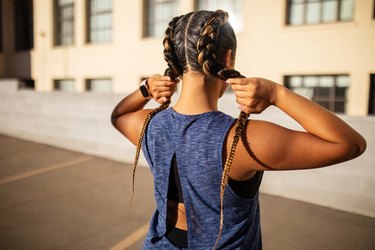
Many of the most popular workout hairstyles mean pulling strands back and away from your face. The last thing you need is hair clouding your vision or getting into your mouth during a weight-lifting session where watching your form is key or while attempting to breathe through a series of yoga poses.
But many go-to hairstyles — like tight ponytails and buns, hair extensions, braids and cornrows — can lead to headaches and hair loss, according to the American Academy of Dermatology.
Video of the Day
Video of the Day
The pull at the root of your hair you feel with tight styles is known as traction. Over time, traction can lead to permanent hair loss, called traction alopecia.
Even if you don't experience issues like an itchy scalp or breakage, the time and energy it can take to style your hair in a certain way for a workout is enough for some people to exercise less, according to a May 2016 research letter in JAMA Dermatology.
The letter detailed the results of a 70-item questionnaire given to people identified in the research as African American women, a group that has the lowest participation in physical activity and highest prevalence of obesity-related conditions.
But even among the physically active women, 18 percent exercised less than they otherwise would have due to their hair's upkeep.
Clearly hair care is a very real imposition to sweating it out. And while the right hairstyle won't solve all hair-related concerns, it can help.
For starters, "you want the hair to have some movement above the scalp so that it does not pull," board-certified dermatologist Karan Lal, DO tells LIVESTRONG.com.
Here are a few doable and accessible modifications you can make to your hair styling the next time you choose to exercise — and tips to keep in mind when doing these hairstyles.
Tip
Salt from sweat has a big drying effect on the scalp and pulls out moisture, according to hair restoration specialist Jigar Sitapara, MD. This goes for all hair types, including his own short, straight hair.
His biggest tip: Stop shampooing everyday. Doing so strips the scalp of natural oils and moisture that causes premature breakage, hair loss and a dry and flaky scalp, he says.
1. Headbands and Head Wraps
"Headbands made from silk or satin are ideal for wicking away moisture," Dr. Sitapara says. "Cotton may dry out the hair's edges and scalp too much."
Dr. Lal agrees: He recommends patients with textured, soft hair wrap their hair around their head and pin it before covering it with a silk scarf.
For Joshua J. Holland, CPT, head wraps and headbands are a must when he exercises to soak up sweat and reduce his frizzy hair.
Shop These Headbands and Head Wraps
- Lululemon Fly Away Tamer Headband II Luxtreme ($12, Lululemon.com)
- Nike Seamless Headband ($18, Nike.com)
- Gymwrap Headband ($21.95, TheGymWrap.com)
- Gymwrap Full Triangle Head Wrap ($25.95, TheGymWrap.com)
2. Ponytails
Ponytails are great for keeping your hair back and out of the way. But if you do use this workout hairstyle, it's best to use loose, gentle hair ties "that pull the hair up or back without adding excessive pulling," Dr. Lal says.
Dr. Lal recommends using thermoplastic polyurethane hair ties, like these from invisibobble (Amazon, $4.99), which are not as tight but still hold your hair in place.
3. Braids and Cornrows
Holland uses braids and cornrows when he trains so his long locks stay off his neck. And while braids and cornrows are effective workout hairstyles, there are still a few things to keep in mind.
The biggest mistake people make is keeping tight braids, like cornrows or French braids, in for prolonged periods of time, Dr. Lal says. These styles "instigate traction, causing permanent scarring that is difficult to treat."
In fact, one-third of people identified as women of African descent have traction alopecia, according to an April 2018 article in Clinical, Cosmetic and Investigational Dermatology. Hairstyles like tight braids and cornrows "over time can rip hair follicles out of the scalp and lead to this permanent type of hair loss," Dr. Sitapara says.
Even so, these tight-to-the-scalp hairstyles are classified as "protective styles" according to a January 2022 literature review of hairstyle trends among Black women in Cosmetics. Protective styles "do not require excessive daily manipulation," the review explains, and they are "exercise friendly," because they keep hair away from the face.
The telltale difference between tight-to-the-scalp hairstyles being protective versus dangerous: Tight-to-the-scalp hairstyles are more protective on natural hair. They're more likely to cause hair loss due to excessive pulling on hair that is exposed to chemicals, because the hair strands are altered at the scalp level.
Dr. Lal recommends looser braid styles, like fishtail braids, as safer alternatives if you plan on keeping your hair up for longer periods of time and you aren't wearing it natural.
If you do choose tighter braids or cornrows, keep them in for a finite period of time, up to two months, like Holland does. "The pain and sensitivity usually goes away after a good sweat or a good night of sleep," he says.
The Bottom Line
Aim to strike a balance with your workout hairstyles, too, Dr. Sitapara says. Just like you do less strenuous workouts on rest and recovery days, give your hair a break, too.
"Climate control is key. Avoid heavy sweating and outdoor workouts in the sun," Dr. Sitapra says. Instead, a less intense, indoor workout — like yoga — will let your scalp "have a rest" from scalp-dehydrating sweat.